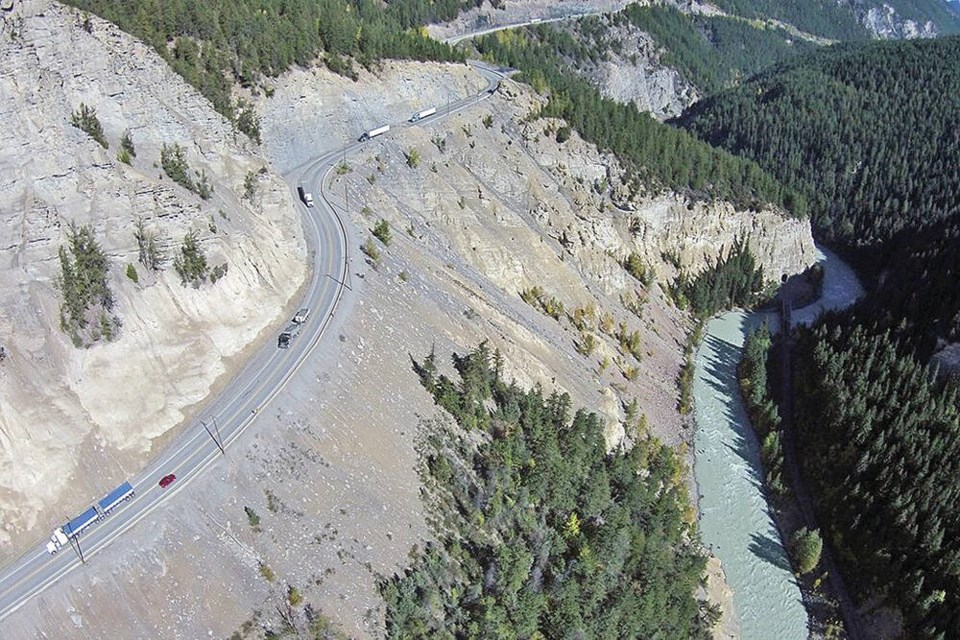LAKE LOUISE, Alta. – Parks Canada is gearing up for an extended two-month closure of the Trans-Canada Highway for twinning of the highway in Kicking Horse Canyon near Golden, B.C.
The closure runs Sept. 26 until Dec. 1, but will be lifted over Thanksgiving weekend Oct. 7-11.
Yoho National Parks and the townsite of Field will remain open during the extended closure, but Parks Canada officials say all through traffic must once again detour on Highway 93 South and Highway 95 as an alternate route.
“The agency has made improvements to highway operations and signage to encourage safe driving practices and improve highway operations,” said Suzanne White, public relations and communications officer for Banff, Kootenay and Yoho national parks in an email.
“Parks Canada works hard to mitigate the challenges of mountain travel but cannot eliminate them.”
The roughly 1.5-hour diversion along Highway 95 between Golden and Radium and Highway 93 South between Radium and Castle Mountain is due to the $601 million upgrades of approximately 4.8 kilometres of the Trans-Canada through the most challenging section of the canyon east of Golden.
Last winter, there were several accidents on Highway 93 South with the increased traffic.
A major winter snowstorm in November that shut down Highway 93 South forced some drivers to spend the night in their vehicles.
Several vehicles lost control during white-out conditions on icy sections of the mountain road, including a semi-trailer that jack-knifed and blocked the two-lane highway during the height of the storm.
This past Sunday (Sept. 18), a vehicle rollover had the southbound lane blocked two kilometres north of Kootenay Pond as traffic was diverted on a temporary basis due to construction in Kicking Horse Canyon.
Parks Canada is responsible for winter maintenance on Highway 93 South in Banff and Kootenay national parks 24 hours per day, seven days per week including plowing, sanding and snow removal.
“In order to maintain this level of service throughout the upcoming fall and winter seasons, we’ve increased staffing levels, modified schedules to meet maintenance demands, and upgraded communications equipment,” said White.
New mitigation measures include installation of new speed readers to notify traffic of their actual speed at select locations and additional lights on recommended speed signs to increase awareness.
In addition, the Storm Mountain brake check area has now been altered from optional to mandatory and the lane markings are being repainted to increase visibility.
Enhanced patrols and enforcement along Highway 93 South will also happen.
“Parks Canada continues to support the RCMP and Commercial Vehicle Safety Enforcement with increased speed and commercial traffic enforcement on Highway 93S,” said White.
Cell phone coverage is not available in Kootenay National Park, however there are emergency satellite phones at Marble Canyon, Kootenay Crossing Operations Centre, Simpson River trailhead and Kootenay River day-use area.
“These phones connect callers directly to emergency dispatch services 24/7,” said White.
“Additional emergency telephone access is also available year-round at the Radium Hot Pools during business hours.
For safety, snow tires, all-season radials or chains are required by B.C. law for travel on Highway 93 South between Oct. 1 and April 30.
Parks Canada reminds travellers that the mountain national parks are dynamic environments with unique challenges, including frequent snowfall with significant accumulations.
Motorists are encouraged to plan ahead and check DriveBC.ca for current road conditions before driving through Kootenay National Park.
“Motorists should slow down and exercise judgment before travelling in poor weather,” said White.
Parks Canada reminds travellers to obey the posted speed limits:
• Reduce your speed and leave more space than usual between you and the next vehicle;
• Avoid using cruise control in the winter;
• Avoid unnecessary braking, especially where black ice may form on bridges, near rivers and lakes, and in the shade;
• Give a wide berth when passing and pulling back in to avoid showering other motorists with snow and gravel;
• Avoid passing operating snowplows and give them time to pull out of your way;
• Keep your fuel levels above half in cold weather;
• Ensure your windshield wipers are working properly and have proper fluid in stock;
• Equip your vehicle with a shovel, flashlight, blanket, food and extra warm clothing; and
• Give yourself extra travel time.



